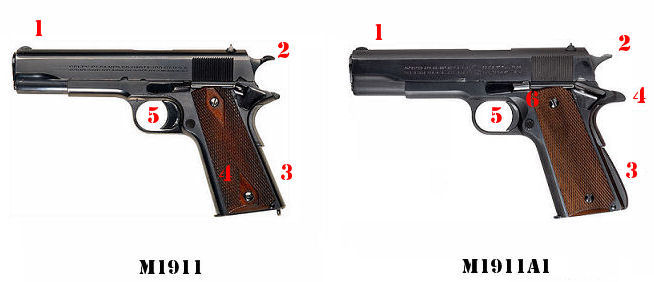Introduction:
Designed by
John Browning and produced by Colt Company,
M1911 is a single-action , semi-automatic, magazine-fed, recoil-operated pistol. It is chambered for the .45 ACP cartridge pistol.There are some rare and commercial models that are double-action or chambered for different non-.45 ACP ammo. Its length is 210 mm, weight 1105 gr when empty w/magazine and uses 7 round standard detachable box magazine.
It served as the standard-issue sidearm for the United States Armed Forces from 1911 to 1986. It was first used in later stages of the Philippine-American War, and was widely used in World War I. Battlefield experience in the First World War led to some more small external changes, completed in 1924 and this new version received a modified type classification - M1911A1, used in World War II, the Korean War, and the Vietnam War.
There are a variety of differences between the original Colt M1911 and Colt M1911A1 pistols as shown below.

1 . M1911-Thin front sight / M1911A1-Thick front sight
2 . M1911-Short Hammer Spur / M1911A1-Long Hammer Spur
3 . M1911-Flat Spring Housing / M1911A1-Arched Spring Housing
4 . M1911-Diamond Checkering on Grip / M1911A1-Long Grip Safety Spur
5 . M1911-Long Trigger / M1911A1-Short Trigger
6 . M1911A1-Relief Cut
U.S. procured around 2.7 million M1911 and M1911A1 pistols in military contracts during its service life. M1911 was replaced by 9mm Beretta M9 pistol as the standard U.S. sidearm in October 1986, but due to its popularity among users, it has not been completely phased out. Modernized derivative variants of the M1911 are still in use by some units of the U.S. Army Special Forces, Navy and Marine Corps.
M1911 is a single-action pistol that means it cannot be fired from hammer-down condition. Unlike a single-action revolver, it does not need to be manually cocked for each shot, as the hammer is automatically cocked each time the slide is cycled. While some consider single-action a drawback, it allows for smoother trigger pull and therefore greater accuracy than double-action designs. It is also one of the safest pistols ever made, with a mechanism-locking engageable thumb safety, a grip safety that disconnects the trigger if the shooter is not actually gripping the weapon, a half-cock position on the hammer, and a spring-retained firing pin that does not rest on the primer and can only be overcome by the force of the hammer dropping from the fully-cocked position. It is impossible to accidentally discharge an M1911.
LRE-35256 includes six M1911 .45 Automatic Colt Pistol 1911 pistols.
Review:
The set comes inside a transparent zip-lock bag sandwiched and stapled in a folded hard cardboard cover. Both sides of the cover show information and photos of the content.
There are six 1/35 scale, grey resin cast M1911 Colt pistols, all served in one sprue. One of the pistols is given in hammer ready/cocked position and another one in slide catch. Resin quality is good, no visible casting mistakes or problems. Details are crisp and clean for this scale. Front and rear sights, hammer and spur, ejection port, diamond checkering on grip and trigger guard are all well defined. Muzzles are given as holes so there will be no need to drill.
Conclusion:
This is a useful kit to have nice detailed M1911s for your World War I and II figures or scenes. Hammer cocked and slide catch variants are good additions to the set.
For more information about this and other products of Live Resin and order information; you may visit Models Hobby
Comments